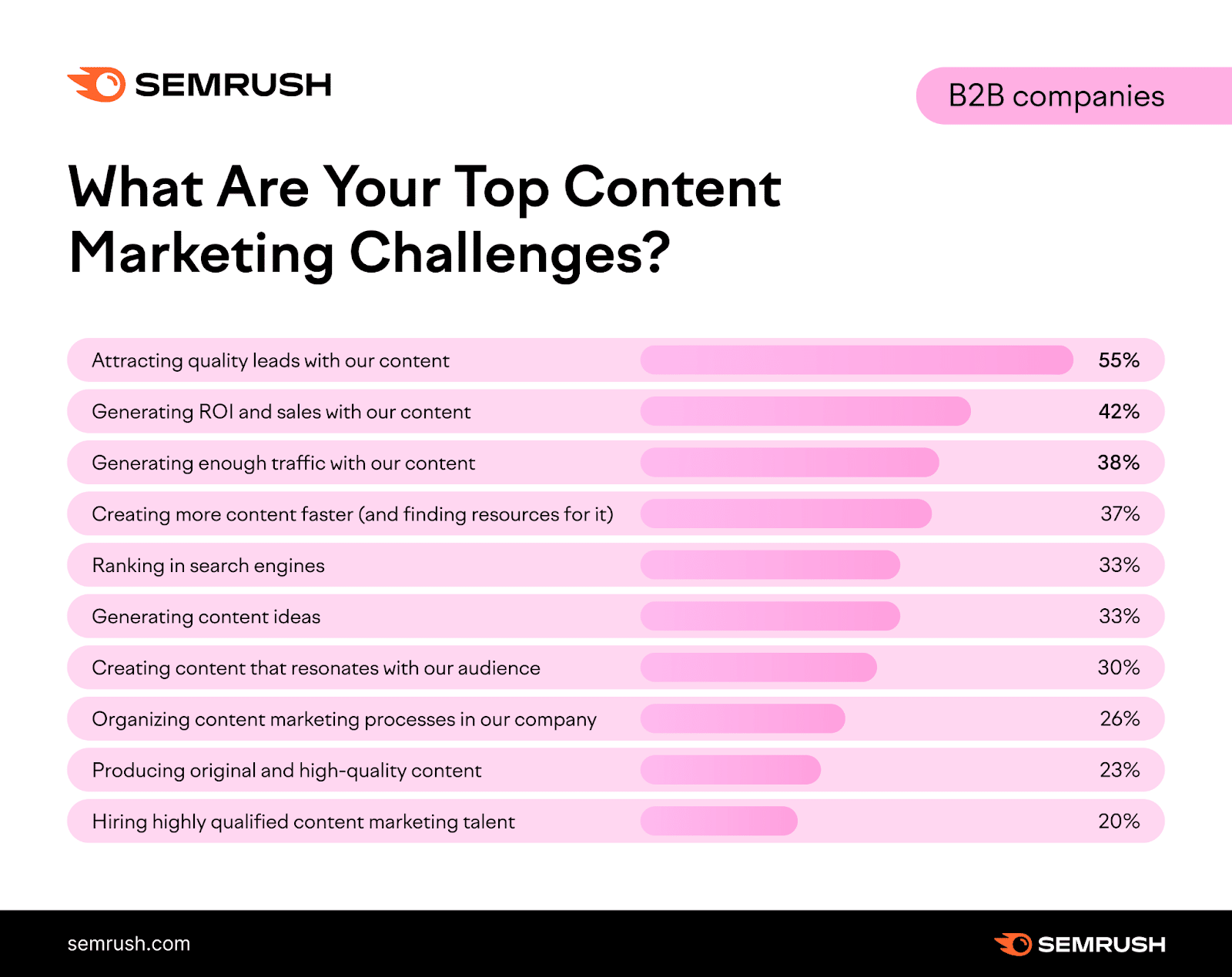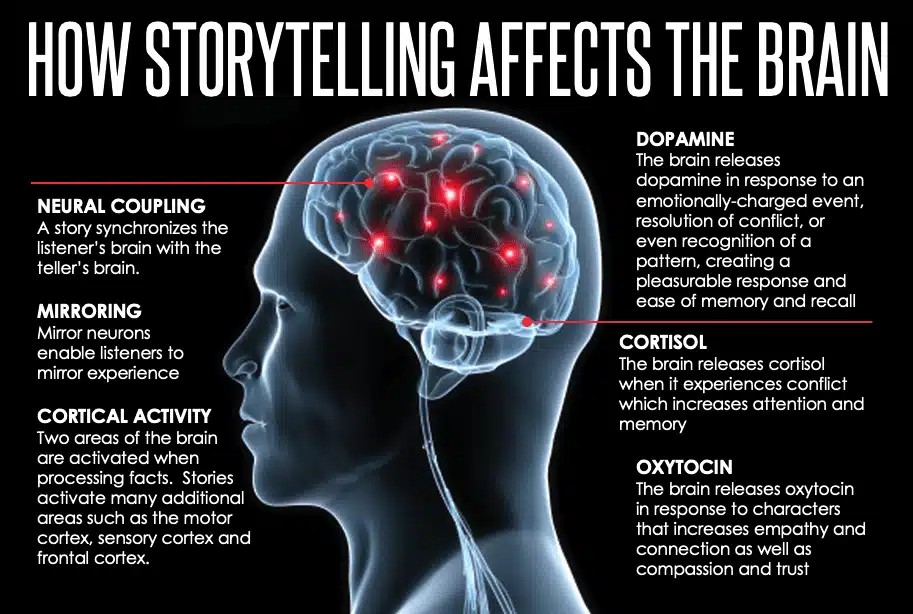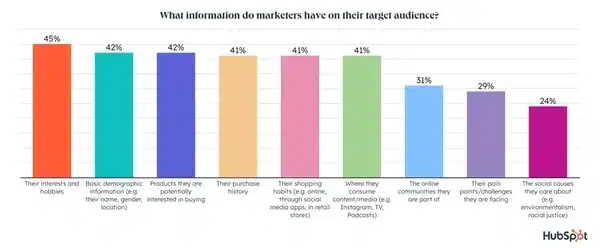
Are you one of the many brands struggling with how to connect with your target audience? 30% of marketers cite creating content that resonates as a top challenge, while 55% find it difficult to attract quality leads.
Today’s buyers demand more authentic and engaging content. Often, the key to reaching them is through storytelling in your content marketing.
However, crafting a compelling plot is a rare talent. Motivating your customers through storytelling is even harder.
Let’s investigate how your brand can follow a few rules to weave a persuasive narrative throughout every piece of content.

Key Takeaways:
- Focus on your customers and make them the heroes of your stories.
- Learn how to use audience testing to create the stories your audience wants to hear.
- Everyone loves an underdog, so highlight the big struggles your audience faces.
- Use simple language and add a visual element to your stories for greater impact.
- Always conclude with a motivating call to action.
1. Grasp Why Storytelling in Your Content Marketing Is So Important
Our love of stories is part of what makes us human. If you lay on the grass and stare at the sky with a friend or family member on a sunny day, it won’t be long before you’ve attached personalities to the clouds and constructed an action-packed drama.
Our brains default to trying to find a story behind everything, even inanimate objects. More than that, good stories stir emotions, move people to action, and create connections.
So, when you use storytelling in your content marketing, you can harness this natural tendency to build a positive relationship with leads and clients. You’ll also inspire them to action.

The difference between using storytelling and simply telling a client something might look like this for a SaaS company:
- Without storytelling: Client A knows and understands she needs an effective software solution. However, she drags her feet on committing to a contract because she still feels concerned about the cost and the possibility of it not working.
- With storytelling: Client B visualizes using your software, imagines the customers she’ll gain as a result, and senses the relief she’ll feel from organizing her business. She is eager to start a trial and learn more.
So, seize the power of storytelling in your content marketing!
2. Appreciate What Storytelling in Content Marketing Is and Isn’t
A lot of brands either try to create a story where there’s none, or they confuse their “story” with a sales pitch. Then, they remain confused about why they’re not connecting with their core audience.
Keep reminding yourself of the following points to avoid common storytelling mistakes.
It’s Not About You!
Storytelling in content marketing isn’t about us; it’s about our customers. We simply become the avatar through which our audience tells their own stories.
For example, when you watch Luke Skywalker or Ahsoka Tano, you see yourself in them. (You probably even practice moves with your invisible lightsaber when no one’s looking.)
Your brand identity should be an expression of what your customers want to project to others. Think about it: You probably have a distinct image of the user when you think about the following products:
- Mac computer = Creative and cutting-edge
- Ford truck = Hard-working and “‘Murica”
- Whole Foods produce = Healthy and eco-conscious
- Patagonia apparel = Outdoorsy and nature-loving
Too many brands don’t take the time to really consider in depth what their audience really wants to know or what interests them. Instead, companies generally focus on how great their brand is and try to shoehorn this into a story.
Nobody wants to sit at a dinner table next to someone who spends the whole night bragging about his achievements. On the other hand, if somebody’s got a compelling story the listeners can see themselves in, you can bet the whole table will be hanging on every word.
It’s Not Necessarily About “Characters”
While storytelling in content marketing can include fictional characters and mascots who represent you or your team, that’s getting more into advertising than marketing. A B2B brand without a mascot can still build a strong implicit narrative that underlies its messaging.
To this end, each piece of content can be part of the story, not necessarily the whole story. Sometimes, an article should just be a helpful list post or a standard definition of important industry terms.
Each time you write a post, imagine the readers progressing through a stage in the buyer funnel and design the info to help them move to the next level (like Super Mario  ). Picture the obstacles that hold them back and provide practical solutions that push their story forward.
). Picture the obstacles that hold them back and provide practical solutions that push their story forward.
Finally, emphasize the great feelings they’ll experience of resolving a pain point. (Here are four quick tips on finding common pain points for B2B marketers:)
3. Get To Know Your Audience (Duh)
Of course, if you’re going to make your buyers the protagonists, you need to know them. Disney’s head of audience strategy, Richard Ellwood, states that the secret to successful brand storytelling is understanding your audience.
Unfortunately, a Hubspot study shows that a startling number of marketers don’t really know their audience. For effective storytelling in your content marketing that engages, inspires, and captures imaginations, you need to grasp what makes your audience tick.

How To Learn More About Your Target Audience
So, how do you find out what your audience wants? Listen to them! (Duh, again.)
Great art (including stories) rarely springs out of thin air. The geniuses at Pixar have a process and formula that led to an impressive batting average when creating moving films.
If you’re not dedicating sufficient time to audience testing and feedback, you’re shooting yourself in the foot before you begin. Take some time today to put audience testing in your schedule and software or consultants in your budget to improve the storytelling in your content marketing.
Why Testing and Metrics Sometimes Fail
Why does audience testing sometimes fail in movies and marketing? Often, it comes down to the wrong tools or the wrong metrics.
Audiences originally didn’t care for the song “Over the Rainbow” in “The Wizard of Oz” or “Part of Your World” in “The Little Mermaid.” The creators had the insight to figure out why that data was wrong and keep those classic numbers in each film.
You’ll need to play around with your tools to discover what factors truly have an impact. Then, you can decide what stories your audience wants to hear and how they want to hear them for maximum effect.
Remember to consider all angles and examine the positive and the negative. Find out what worked (or didn’t) and why to create your own storytelling formula for repeat success.
4. Choose the Right Kind of Story for the Occasion
Depending on the channel or the purpose, you’ll focus the storytelling in your content marketing differently. Stories fall into one of the following four areas:
- Customer-focused: Use testimonials and case studies as powerful social proof that shows why buyers need your solution.
- Product-focused: Highlight the benefits of your product and how it solves a pain point for your customers.
- Branded: Make your team more personable by telling a little about who you are through your values, history, and personality.
- Industry-focused: Go broader to discuss the importance of your field and current events with thought leadership pieces that display your expertise.
How do you determine which of these stories to use and when? Look for the intersection between relevance to your target audience, brand message, marketing goals, and the emotions you want to convey.
Once again, getting this right will take testing and practice. That’s why consistency in your content creation is critical.
5. Create Tension To Trigger Emotions
Everybody loves happy endings, but storytelling in your content marketing where nothing happens is boring. What engages people are tales of triumph over adversity, so lean into discussing those pain points.
When the hero comes up against a challenge, we feel their pain and disappointment. We’re rooting for them to succeed, and we feel accomplishment and relief when they prevail – almost as if we’d experienced it ourselves.
I’ve delivered a popular webinar for Harvard Business Review on how to deliver Presentations That Connect. The talk helps executives turn their typically boring presentations into compelling stories.
Many execs default to trying to convince potential investors of how great their company or proposal is by pointing out only the good points. In contrast, I suggest using the basic storytelling technique of introducing conflict and a villain to spark interest.
By acknowledging problems, negatives, and challenges in your content, you’re being more truthful and authentic. You’re also telling a better story.
6. Take Storytelling Beyond Text and Get Visual
If you still sense that the storytelling in your content marketing is lacking, it might be time to stop focusing on the actual words you say. Start enhancing your stories with effective visuals.
Images
They say a picture tells a thousand words, but how much thought are you putting into your imagery? Extra effort could improve your storytelling exponentially.
For instance, many corporate blogs follow the tried-and-true standard of illustrating their posts with typical stock photography. (Have you noticed how the same pictures and people keep popping up in business articles?)
If you merely want to add visual interest to your copy, stock photos are okay. However, you should think about how images can improve your story or even tell it entirely.
Infographics, for example, are a highly effective way of communicating information that people find more engaging than a wall of text. Also, consider custom illustrations or just better photography.
If nothing else, images will grab your reader’s attention. As a result, the audience will be more likely to read your words.
Video
Everyone knows how effective video can be for telling a good story. Well, people are more likely to watch and share a short, interesting video than any other type of content.
You can use videos to illustrate and add extra value to the storytelling in your content marketing, or they can be effective standalone pieces of content in their own right. You don’t even have to create your own videos.
Remember when I shared a clip earlier in the article about customer pain points? The beauty of YouTube is that creators are happy to share their work with anyone who can make use of it, so start adding video links to your content today.
7. Play With Different Techniques and Perspectives
If you’re not growing in your business and marketing, you’re dying. The same principle applies to creativity. Look for new methods and techniques for storytelling in your content marketing so you can keep your readers engaged.
Getting a fresh perspective can be as easy as inviting people to guest post on your blog. You should also take advantage of your team members as a resource for planning and writing articles.
Another way creators boost speed and efficiency while bringing a new outlook is by hiring ghostwriters. Provide a professional writer with an outline and your viewpoint on a subject and let them bring it to life in new and exciting ways.
8. Use Down-To-Earth Language
Speaking of the hero’s journey from earlier, Mark Hamill (have I mentioned that I met him?) knows a little something about that. While it pains me to say it, one of George Lucas’ weak points in storytelling is the dialog.
(Who remembers the infamous “I don’t like sand” scene?)
Even here at MIG, we continually remind writers to take the language down a notch to a more readable level. What’s more important than following a stylebook or coming up with big words is connecting with people in a genuine way while storytelling in your content marketing.
Great tools like Hemingway Editor can help you check if your sentences are too long and clumsy. Don’t bury a great narrative under a mountain of fancy words.
9. Take Inspiration From Others
Great storytellers know how to steal from others. I’m not telling you to blatantly plagiarize, but the beats of the classic narrative structure have remained the same over the ages.
The best tip is to crib pointers from another industry or “genre.” Lucas found inspiration from Japanese samurai stories, and “The Dark Knight” owed more to thrillers than previous superhero films.
You can do the same with the storytelling in your content marketing. Here’s a great recent example: Comedy has long been common in cereal and fast food ads, but only a couple of decades ago, humor wasn’t part of the serious (and bland) subject of insurance.
Geico changed the game with its gecko, pig, and caveman ads. Now, for better or worse, all of the insurers are doing something similar.
A few of the brands I recommend checking out for inspiration are Zendesk, Warby Parker, and SoulCycle. Learn from companies who consistently get it right, then make it unique enough to call it your own.
10. Stick the Landing
Your ultimate goals in this process are conversions and sales, so begin with the end in mind. Are you going to wrap things up successfully, like “Cheers,” “Breaking Bad,” and “The Good Place,” or flub your finale, like “Dexter,” “Lost,” or “Seinfeld”?
Don’t tell stories simply for the sake of telling stories. Your audience should clearly know what to do at the end of each interaction when you use storytelling in your content marketing.
Make sure each piece has a crystal clear call to action that tells your reader or viewer what to do next. Specific objectives help us measure the effectiveness of the content we create for clients, and it will help you, too.
Want To Integrate More Storytelling in Your Content Marketing?
These tips will immediately help you start telling more compelling stories. However, you probably struggle with finding the time to add another essential item to your neverending to-do list.
If you’re ready now to draw more traffic and leads to your site with consistent, high-quality storytelling in your content marketing, check out our Content Builder Service. Set up a quick consultation, and I’ll send you free PDF versions of my books as a thank-you!

0 Commentaires